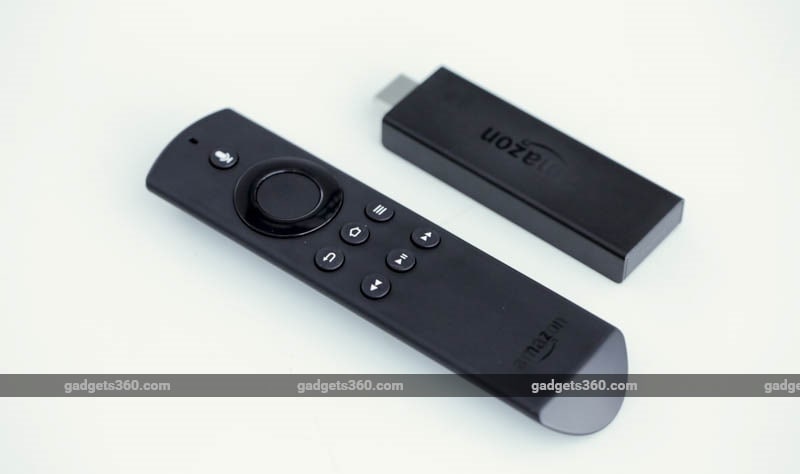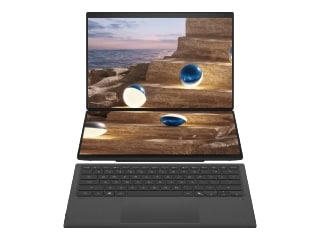- Home
- Tv
- Tv Reviews
- Amazon Fire TV Stick Review
Amazon Fire TV Stick Review

When Amazon launched its subscription-based streaming service Prime Video in India late last year, one of our biggest gripes – apart from its confusing stance on censorship – was the fact that there wasn’t a convenient way to get the experience on your big screen. You either had to rely on an Apple TV for its AirPlay feature, or fall back on hooking up your computer to your TV with an HDMI cable - not ideal at all.
The reason for that is Amazon’s choice to not play nice with others. It doesn’t make an app for Apple TV, and it doesn’t support Google’s Chromecast on Android. Instead, the company prefers that users buy its own hardware – the Fire TV lineup. You couldn’t buy one of these in India for the longest time, but that changed last week, with the arrival of the Fire TV Stick.
Amazon Fire TV Stick specifications and features
The Fire Stick looks like an oversized USB thumb drive, with an HDMI connector on one end and a Micro-USB socket on one side. You plug it directly into your TV, or use the included HDMI extension cable if it won’t fit. To power it, connect the included Micro-USB cable to one of your TV’s USB ports (or any other charger). On first boot, if it warns you that it can’t draw enough power, you should use the supplied mains adapter instead. If your TV is wall-mounted and doesn’t have recessed ports, you’ll have to deal with the ugliness of the power cable trailing out.
If you’re wondering why the device needs more power compared to a Chromecast - which will play nice with practically any USB port - that’s because the Amazon Fire TV Stick has a quad-core processor and 1GB of memory. It has enough processing power to play even H.265 (HEVC) files, which only the more expensive Chromecast Ultra is capable of doing. With this capability, Amazon can deliver your videos quicker – H.265 is heavily compressed and requires less bandwidth than H.264. On our 25Mbps home broadband line, Mr. Robot jumped to 1080p – the maximum resolution output supported by the Fire TV Stick – within a couple of seconds.
The heavy compression doesn’t affect video quality, and should allow other family members to enjoy the Internet when you are watching full-HD video streams, depending upon your connection speed of course. On the connectivity side, you get support for both Wi-Fi 802.11ac and Bluetooth 4.1. The latter has dual benefits – you don’t need to point the included remote at the TV for it to work, and you can hook up a pair of Bluetooth headphones.
![]()
The voice remote is one of the best things about the Fire TV Stick, something you don’t get with a Chromecast. The nice curve on the back lends itself to an easy grip, and the button in the middle of the navigation pad has a lovely ergonomic feel to it. Amazon used to provide an inferior remote with the original Fire TV Stick, but this is the second-gen model, and it has the same remote as the more expensive Fire TV.
The remote’s most important feature is its voice button – you just hold it down, name a movie, TV show, or app, and Amazon can look it up. It’s a neat feature, but doesn’t work exactly the same in India as it does abroad - more on that later. If your TV supports the HDMI-CEC standard (HDMI Consumer Electronics Control), you can turn it on by pressing any key on the Fire TV remote and also use your TV’s remote to control the Fire TV interface.
Amazon Fire TV Stick performance
Amazon has its own Fire OS for its devices, which is a custom fork of Android’s underlying code. The Fire TV Stick comes with Fire OS 5.2.4.1, which is based on Android 5.0 ‘Lollipop’, but there’s no way you could tell by looking at it. Amazon has greatly improved the Fire TV lineup’s UI over the years, settling on a pleasing interface that resembles the new Android TV look.
Setting up a Fire TV Stick is easy. If you order one from Amazon.in, it will come with the credentials of the account you used already set up, so you can skip that part. On-screen keyboards are usually a nightmare for typing, what with having to travel to each key manually. Here, it’s also disorienting, since Amazon saw fit to arrange the keys in A-Z order instead of QWERTY. Thankfully, you can use the Fire TV remote app, available for Android and iOS, to navigate and type more easily.
Once you’re in, you’ll see five main tabs across the top – Home, Movies, TV Shows, Apps, and Settings – and they all behave as you’d expect. Each tab has a Featured section at the top that lists a few titles, and then you get rectangular tiles for recently used apps and videos. Fire OS prioritises Amazon’s own Prime Video service. If you leave a title midway, it takes up the first slot on the Home tab so that you can pick right up where you left off. The remote has buttons for play/ pause, rewind and fast forward, but you’ll have to use your TV remote to manage volume.
Since Fire OS is not technically Android, it doesn’t have access to Google’s apps and services, including YouTube. Instead you are served a TV-optimised version of the website.
![]()
For what it’s worth, you do get a wide selection of apps to choose from and install, including Netflix, Hotstar, Airtel Movies, Voot, Eros Now, Sony Liv, Twitch, and even specialist sources such as TED, NDTV, Bloomberg, and NASA. While most apps run fine, some Indian apps such as Hotstar and Eros Now need to be optimised. We experienced random crashes and bugs, which you can read about in detail.
You can get the VLC or Plex apps to play content over a network location such as a computer or a NAS. If you’re willing to tinker a bit, you can even get Kodi up and running. Since Fire OS is based on Android code, it’s possible to install most third-party apps. All you have to do is get a browser such as Mozilla Firefox, download the desired APK files, and install them using ES File Explorer, which is readily available via the Amazon App Store.
On the music front, the only option at the time of writing is Gaana. Apple hasn’t built an Android TV app for Apple Music, and Fire OS can’t work with Google Play Music either, for reasons mentioned earlier. Other options – Amazon Music, Spotify, Pandora, and Vevo – aren’t available in India.
There are about 60 games available in the Amazon App Store, though popular big titles such as Crossy Road, Pac-Man 256, and Alto’s Adventure are missing. There are versions of common casual games like Solitaire, Teen Patti and FreeCell, plus a lot of knock-offs of existing games, such as Crazy Goat instead of Goat Simulator. The only major names are Flappy Birds Family and Lego Star Wars: The New Yoda Chronicles, the latter being part Temple Run, with a bit of space warfare thrown in. The graphics are far from impressive, but you shouldn’t expect much from Fire TV Stick’s hardware in terms of gaming performance anyway.
Because of this limited selection and the fact that Amazon hasn’t launched the Fire TV Game Controller here yet, gaming isn’t one of the Fire TV Stick’s strengths. Holding down the remote’s circular pad instead of an analogue stick can leave your fingers sore. Games can also be much heavier than ordinary apps, and you’ll need to keep an eye on your free space. Only about 6GB of the Fire TV Stick’s 8GB is available for your use, and there’s no way to expand this.
![]()
No Alexa, and no universal search
At the device’s India launch event, Amazon boasted that the Fire TV’s voice search feature can pick up Indian names. We were sceptical of this promise, but it worked near flawlessly in our testing. From movies (Jaane Bhi Do Yaaro) to actors (Amitabh Bachchan), Fire OS does a great job of picking up what you say. You can ever search by director or genre, but don’t expect the search feature to go any further.
Fire OS in India is a severely dumbed-down version of its true self. For one, Amazon’s voice-based assistant, Alexa, won’t work, which means your dream of controlling media and ordering pizza with voice commands has been dashed. If you tell your remote to “launch Netflix” or “skip ahead 10 minutes”, it will just launch a search for that exact phrase, not do as you say.
What’s worse is that universal search is also missing. Fire OS doesn’t seem to be indexing the content of any services other than Amazon Prime Video – so you have to launch different apps if you want to watch a Netflix exclusive show or an IPL match, for example. With so many different streaming services available – Netflix, Hotstar, and Eros Now among them – it would have been helpful to be able to search for a title across them all, rather than launching each one in turn to check if, say, Andaz Apna Apna is available.
In the US, Amazon expanded this capability to cover more than 75 content sources last year. In India, the Prime Video catalogue is relatively small. This severely undercuts the appeal of a Fire TV Stick, and we hope that Amazon is working with developers to add their catalogues to the mix in the near future. If you’re not an Amazon Prime member, the Fire TV Stick’s lack of indexing and restricted search will be even more disappointing.
We reached out to Amazon India on the various shortcomings of the Fire TV Stick – the lack of voice commands, universal search, and plans for the Fire TV box, and the Gaming Controller. A company representative told us that although those things are part of the roadmap, they didn’t have the liberty to discuss it any further.
![]()
At launch, Amazon is giving buyers a number of freebies to sweeten the deal. They include some cash back as Amazon Pay balance, free data for Airtel Broadband and You Broadband subscribers, and limited-time premium subscriptions to Eros Now, Gaana, and Voot. The catch here is that the Amazon Prime and content offers don’t apply to existing members. You’ll need to sign up with new accounts to take advantage of the cashback or free premium services.
Verdict
At Rs. 3,999, the Fire TV Stick sits neatly alongside that other streaming stick – the Chromecast – which has become massively popular over the last few years. The two are regularly touted as rivals, but even though both are built for streaming content, they are quite different in their approach.
The Chromecast is made for people who know what they want to watch. You open an app on your phone, and then cast it to your TV screen. The Fire TV Stick, by comparison, encourages that old TV habit of browsing around, and thanks to its interface, we did find ourselves going through apps that we might normally not bother with.
If you watch a lot of Prime Video content, then the Fire TV Stick will surely appeal to you. For everyone else, Google’s Chromecast will continue to prove useful, more so since it you can use it with a variety of apps.
Voice commands and universal search are the two most obvious benefits of the Fire TV Stick, but those legs have been cut off for Indian audiences, leaving behind a not-so-smart product that does few things, but does them well.
Catch the latest from the Consumer Electronics Show on Gadgets 360, at our CES 2026 hub.
Related Stories
- Samsung Galaxy Unpacked 2025
- ChatGPT
- Redmi Note 14 Pro+
- iPhone 16
- Apple Vision Pro
- Oneplus 12
- OnePlus Nord CE 3 Lite 5G
- iPhone 13
- Xiaomi 14 Pro
- Oppo Find N3
- Tecno Spark Go (2023)
- Realme V30
- Best Phones Under 25000
- Samsung Galaxy S24 Series
- Cryptocurrency
- iQoo 12
- Samsung Galaxy S24 Ultra
- Giottus
- Samsung Galaxy Z Flip 5
- Apple 'Scary Fast'
- Housefull 5
- GoPro Hero 12 Black Review
- Invincible Season 2
- JioGlass
- HD Ready TV
- Laptop Under 50000
- Smartwatch Under 10000
- Latest Mobile Phones
- Compare Phones
- Motorola Signature
- Vivo Y50e 5G
- Vivo Y50s 5G
- Realme 16 Pro+ 5G
- Realme 16 Pro 5G
- TCL Nxtpaper 70 Pro
- OPPO A6 Pro 5G
- Honor Power 2
- Asus ProArt PZ14
- Zephyrus Duo 16 (2026)
- Realme Pad 3
- OPPO Pad Air 5
- Xiaomi Watch 5
- Huawei Watch 10th Anniversary Edition
- Acerpure Nitro Z Series 100-inch QLED TV
- Samsung 43 Inch LED Ultra HD (4K) Smart TV (UA43UE81AFULXL)
- Asus ROG Ally
- Nintendo Switch Lite
- Haier 1.6 Ton 5 Star Inverter Split AC (HSU19G-MZAID5BN-INV)
- Haier 1.6 Ton 5 Star Inverter Split AC (HSU19G-MZAIM5BN-INV)

















